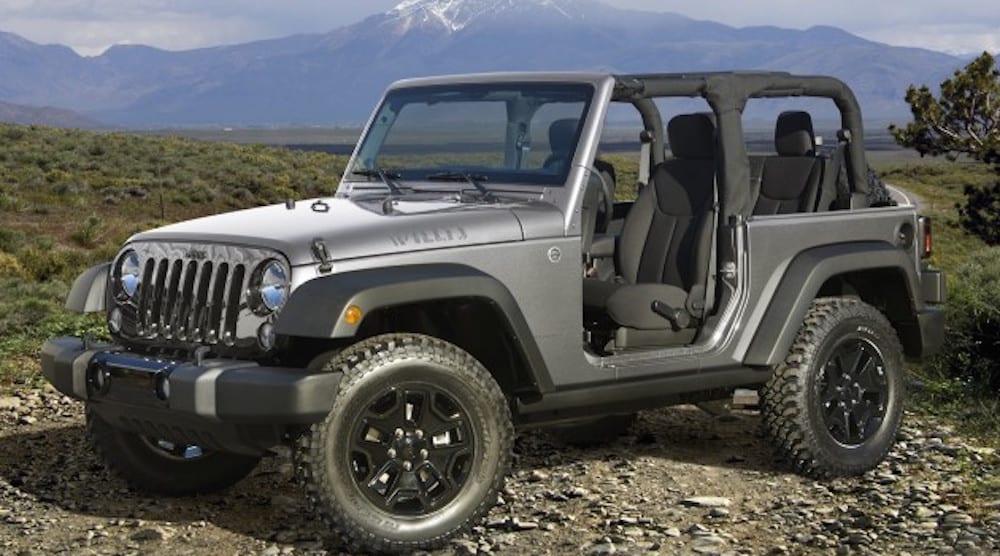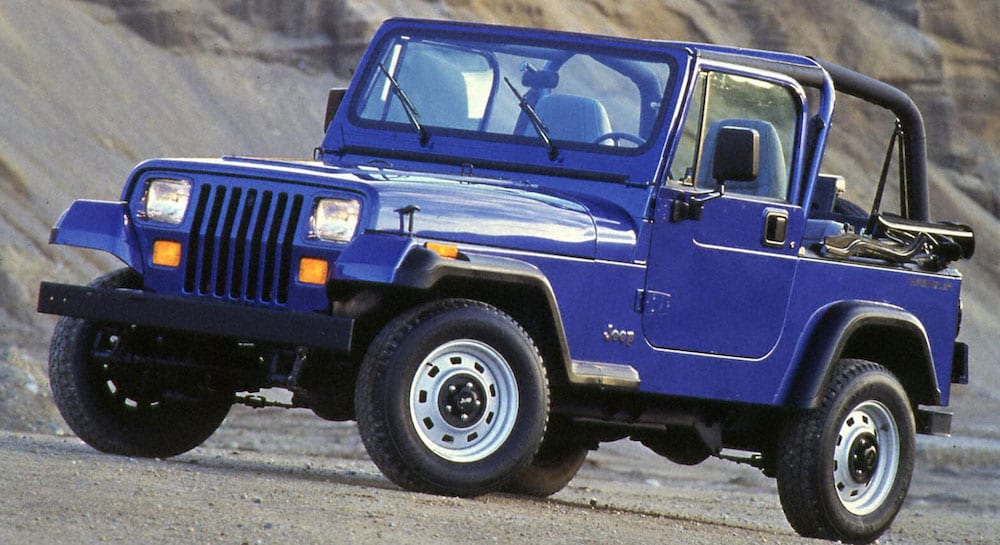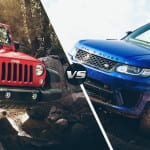First announced on May 13, 1986, the CJ-7 lookalike featured an entirely new design, with the company focused on a different “product philosophy.” What was this philosophy?
Similar to the Willys MB and the Jeep CJ, the Wrangler used a separate body and frame (albeit with a revamped design), front and rear live axles, a fold-flat windshield, and it offered the ability to remove the doors. However, engineers also included aspects from the “new” Cherokee XJ, including the suspension, drivetrain and interior design.
This made for one of the most popular Jeep models yet, which has been indicated via the record sales. To learn more about the 2016 Jeep Wrangler‘s predecessors, continue reading below…
YJ (First Generation)
The Wrangler first made its debut in 1986, replacing the beloved (but poorly-selling) CJ. Many people assume that the vehicle was an actual follow-up to the CJ or even the World War II Willys MB, which wasn’t an unreasonable assumption. After all, the Wrangler was produced at the Brampton, Ontario, Canada plant, the same location that had produced the Willys Jeep during the war. Furthermore, the vehicle essentially replaced the CJ’s place in the Jeep lineup, so it was understandable that potential customers would be confused.
However, the Wrangler was its own breed… a hodgepodge of different Jeeps, if you will. To further emphasize the point that the CJ did not transfer over to the Wrangler, the brand included a small factory dash plaque on the final CJ produced:
“Last of a Great Breed – This collectors edition CJ ends an era that began with the legendary Jeep of World War II.”
Luckily, the Wrangler made the CJ’s demise more bearable. In an attempt to attract more casual drivers, the engineers revamped their vehicle to present a more comfortable on-road experience. The new design featured a wider track, less ground clearance, and a more comfortable interior. The lead spring suspension remained, although the unit was wide and included trackbars and swaybars to help improve handling.
The Wrangler’s body design was similar to the CJ, although there were several new additions to the exterior. Engineers added a new grille, a larger windshield, and two controversial inclusions: rectangular headlights and wiper blades that rested on the windshield (to compensate for the larger glass).
The YJ featured a standard 2.5-liter AMC 150 I4 engine, or customers could opt for the 112-horesepower 4.2-liter AMC 258 I6 engine. A fuel-injected 180-horsepower 4.0-liter AMC 242 engine was eventually included, as well.
The YJ became a popular choice among United States boardwalks, as the vehicles were slightly modified to serve as tram cars. Powered by an exclusive 2.5-liter Power Tech I4 engine and an automatic transmission, the YJ’s were used (specifically in Ocean City, Maryland) for years. These Jeeps were eventually replaced by the Wrangler JKs.
The first-generation Wrangler saw several changes over the years. Anti-lock brakes were eventually added in 1993, as was an automatic transmission and a center high-mounted brake light. Through it’s nine years in production, there were 632,231 YJs produced, although more than 50,000 were still made in 1996 (a year after the first generation was discontinued).
TJ (Second Generation)
There were no Wranglers for the 1996 model year, although (as we previously mentioned) several TJs were still produced and sold as 1995 models. The TJ made its debut in 1996 as a 1997 model, featuring improved handling with a new coil-spring suspension (taken from the Grand Cherokee). The TJ also featured the long-awaited return of the popular rounded headlamps.
The vehicle was initially accompanied by a 2.5-liter AMC 150 Inline-4 engine, and that was later replaced with the 2.4-liter DOHC four-cylinder unit. Customers could also opt for the 4.0-liter AMC Straight-6 engine, which was available throughout the model’s runs. All of these were accompanied by standard 19-gallon fuel tanks by 1998.
There were several changes to the TJ during it’s 10 years (1996 through 2006) in production. The side door mirrors switched beween a “black metal” design and “plastic molded,” and the hard and soft tops were also revamped slightly through the decade. The three-speed automatic transmission was eventually replaced by a four-speed automatic, and the 30/32RH tires were replaced by 42RLEs. Finally, the interior was slightly revamped, featuring a rounder design that help accentuate the back and headrest areas.
The TJ may be most notable for its inclusion of AMC-related parts, the last production vehicle to feature the company’s materials. Several of these parts were deemphasized over time, like the AMC Straight-4 engine (2002) and the AMC Straight-6 engine (2006).
JK (Third Generation)
The current-generation Wrangler was commissioned by DaimlerChrysler in 2001. The company actually held a contest to design the new Jeep, with Mark Moushegian beating out Dan Zimmerman (who’d later play a role in the design of the Jeep Hurricane Concept). By 2004, the JK was close to three years ahead of production, and by 2004, the company was showing off their new vehicle at auto shows.
The JK finally hit the market in 2007 with a complete redesign, featuring four doors and an all-new chassis. The vehicle was also significantly wider than its predecessors, as it featured a 3.4-inch wider track (although, ironically, a 2.5-inch shorter length). If you upgraded to the Wrangler Unlimited, you’d see a wheelbase increase of over 20-inches.
The vehicle has primarily been accompanied by three engines during its run. For the first four years, customers could go with the 3.8-liter EGH engine, which could pump out 202 horsepower and 237 pounds-feet of torque. Later, customers could go with the 2.8-liter VM Motori turbodiesel straight-four engine (177 horsepower and 320 pounds-feet of torque) or the 3.6-liter Pentastar unit.
The vehicle featured several new technological safety features, including stability control, which assists in keeping your vehicle on its intended path. The vehicle also included an off-road tuned anti-lock braking system, as well as a new traction control system with electronic limited slip differential. Interestingly, the majority of the vehicle’s functions (including the engine, transmission and braking) are run through the Jeep’s computer software. Hill Start Assist (prevents your vehicle from rolling back) and the Trailer Sway Control (keeps your towed cargo on its path) were among the changes to the 2009 model.
There’s no denying that customers and critics have grown to love the Wrangler, and that sentiment can be confirmed by awards and the vehicle’s sales.
The Wrangler won the 2009, 2012, and 2013 Best Resale Value Award from Kelley Blue Book, and it won similar awards from Canadian Black Book from 2011 through 2013. The Jeep received the Four-Wheeler of the Year Award in 2007 and 2013, and it was eventually named to Business Week’s 2009 list of the “Most Iconic Cars of the Last 20 Years.”
Sales were steady for the first several years of production, but after reaching an all-time high of 119,243 units sold in 2007, the number dropped to only 84,615 in 2008. Since then, sales have continued to grow in the United States, peaking with 175,328 units sold in 2014.
One more thing: the Wrangler is a record breaker. The vehicle set the Guinness World Record for the highest altitude attained by a four-wheeler after traveling to the top of Chile’s Ojos del Salado (the highest volcano in the world). The entire trek took just under a week to complete, and the Wrangler ultimately ended up climbing 21,04 feet in the sky.
As you can see, the Wrangler’s history may be short, but it’s already been action packed. We can be assured that the company will continue to upgrade the Jeep, and we’re confident it will remain one of the most popular vehicles on the road.




